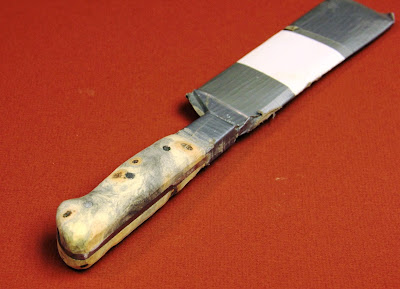Well the bottom line is that, like so many things in life, I created stress where there was no reason for stress. The task was actually not as difficult as I had first imagined. As a first step, I searched the internet (and more specifically YouTube), for information on how to attach pieces of wood to the knife tang and make a handle out of it. As you might imagine, it’s all there. Also, as you might imagine, there are a number of different approaches or techniques. Most of the techniques use epoxy to hold the wood handle parts to the metal tang, and that’s the direction I took. Of course, you have to use metal pins to hold the whole thing together, but with the use of the epoxy, there is no need to peen the pins to secure the wooden halves as you might expect. I used some common sense and left some exposed wood in all directions for sanding. Even though I normally hate sanding most wooden objects I make, I have to admit that sanding and shaping the knife handle was actually fun. My stationary belt sander was quite useful in the shaping.
 |
| I wrapped the blade and the exposed metal in duct tape to protect the finish, and my hands. |
 |
| During the shaping on the belt sander, I scraped the metal on the handle. This came out with steel wool and buffing. |
 |
| I used tung oil for the finish, and fine sanded between each coat to get a very smooth result. |
Of course I couldn’t just hand him the knife, so I
fixed up one of my flat cigar boxes as sort of a “presentation box”. I must admit, I was pretty proud of the final
result. Now that I am an “expert” at
making knife handles, I’m starting to look into knife kits on the internet. Have any of you had any experiences with
making knife handles? If so, I would
love to hear about them.
 |
| The finished knife in a presentation box |



















